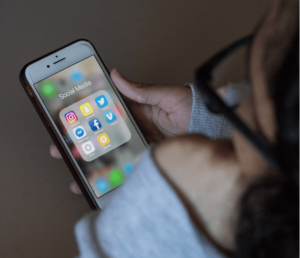by Andrea Traietti on April 4, 2019
Opinion

YES by Elizabeth McGinn ’21
Social media unfairly has a horrible reputation; upon a deeper look, however, creativity is actually bolstered by social media.
Artists can use apps to promote their content to the world with the press of a button. From graphics and comics to makeup artists and food blogs, Instagram and other forms of social media provide the perfect platform for self-made creators. Without needing to pay for screen time or print advertisements, all forms of art can easily reach a wide audience.
Instagram, even at its most basic level, can spark a renewed interest in photography. Visual creativity is often underscored as an art, but it can create stunning images of modern life.
Influencers, despite the poor public image of some, also contribute to this creative process. New clothing lines can sponsor an influencer, whose followers then are exposed to the up-and-coming brand. Novice fashionistas can scour Instagram for new outfit ideas and potentially establish an influencer page themselves.
For the traditional artists, Instagram bypasses the elitism of the art scene. Before social media could act as a platform for displaying art, most creators had to personally know someone to share their content.
By uploading to Instagram, however, each artist can individually promote and showcase their works to prospective buyers.
In particular, graphic artists of comics enjoy a renaissance on social media. The creation of memes, which usually requires humor and design skills, floods apps with entertainment. Through these talents and platforms, the artists can relay their success into established graphic design or continue to captivate the world with their hilarious memes.
While Instagram relies on photos, Twitter focuses on words. In a maximum 280-character Tweet, users must carefully choose their words, and successful tweets require careful deliberation. Developing humor in 280 characters is surely an art form that creates joy in everyday life.
Instagram and Twitter are some of the most popular apps among college-aged students, but several others exist that can also provide an opportunity for creative flourishing, like editing and design sites. The next time you take a picture for Instagram and search for the correct lighting and angle, enjoy your creative process.
NO by Alyssa Cohen ’21
While social media has engendered improvements in communication, connections, marketing, and self expression, the risks such online networks present may run deeper than fostering social ineptitudes in America’s youth—they may also be depleting younger generations of their creative potential.
While social networks establish a valuable public forum for artists and other creators to publicize their work and inspire others, they prove a more significant hindrance in enabling an individual to explore his or her creative potential in the first place.
Despite the fodder for creativity social media provides, such networks concurrently present a more significant distraction from harnessing this creative energy needed to actually create.
Essentially, as a large percentage America’s youth endures an addiction to social media, in accordance with the societal glorification of being busy, contemporary teens and young adults no longer grapple with boredom.
The majority of contemporary youth keeps an iPhone at their fingertips that perpetually enables the individual to extinguish any sense of boredom instantaneously through accessing social media.
In turn, the majority of American teens and youth possess few creative hobbies, as they no longer experience the mental stimulation that impels the creative process in an effort to fill the void.
To that end, rather than utilizing free time as a means of self discovery through the creative process or engaging in activities evocative of the creative spirit, many people scroll through an endless stream of posed photos of people they may barely know.
Essentially, the depletion of creative spirit that social media engenders, aside from the glorification of superficiality and the mental health concerns that such online networks impose, proves pernicious to American culture at large. Generations of uncreative adults will undoubtedly lend to a stagnancy in art and innovation within our society.
That considered, once modern teens and adults can acknowledge their addiction and instill an awareness in themselves of when social media usage is hindering them from exploring their creative process and consciously appreciating the world around them, social media may be utilized as a tool of innovation and expression rather than a suppressor of creativity.